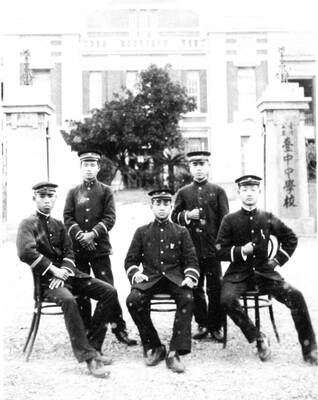Atop a hill, a chain saw drowned out loudspeakers broadcasting a lama’s chants from a nearby temple.
The chain saw, wielded by workers demolishing a row of homes, signaled the imminent end of thousands of hand-built monastic dwellings at Larung Gar, the world’s largest Buddhist institute.
Since its founding in 1980, Larung Gar has grown into an extraordinary and surreal sprawl — countless red-painted dwellings surrounding temples, stupas and large prayer wheels. The homes are spread over the walls of this remote Tibetan valley like strawberry jam slathered on a scone.

Photo: AP /Ashwini Bhatia
Larung Gar has become one of the most influential institutions in the Tibetan world, the teachings of its senior monks praised, debated and proselytized from there to the Himalayas. In recent years, disciples have popularized a “10 new virtues” movement based on Buddhist beliefs, spreading its message across the region.
Now Chinese officials are tightening control over the settlement, in what many Tibetans and their advocates call a severe blow to Tibetan religious practice.
On a recent afternoon, workers in hard hats were dismantling cells that monks and nuns had built along a ridge. As they tossed aside wooden beams and plastic sheeting, nuns picked through rubble looking for their belongings. Men who appeared to be plainclothes police officers looked on from a bench across the street.
Hundreds of Buddhists had already been forced out of the area. A monk watching the destruction from a ledge told me he was staying in a home across the valley. Like others interviewed for this story, he spoke on the condition of anonymity to avoid reprisal from the authorities.
“I heard my home will be demolished,” he said. “I don’t know whether I’ll be allowed to stay.”
FEAR, RESENTMENT
Tensions between Tibetans and the Chinese government have been high since a widespread uprising across the Tibetan plateau in 2008. Suppression of their culture and religious life remains at the heart of Tibetans’ grievances, and restrictions at important religious institutions like Larung Gar stoke that resentment.
Many Tibetans say they fear the erosion of their language, traditions and ways of worship. China still denounces the Dalai Lama, the Tibetan spiritual leader, and bans his image throughout the region.
Some estimates put Larung Gar’s population at 20,000, many of them clergy who have flocked there from far corners of the vast plateau. Buddhist practitioners who are Han, the dominant ethnicity in China, live alongside Tibetans in the settlement, which is a winding 16-hour drive from the provincial capital, Chengdu.
Interviews with residents at Larung Gar and reports from Human Rights Watch, Radio Free Asia and overseas pro-Tibet groups indicate that officials intend to reduce the settlement’s population to 5,000 by late next year through mass evictions. During the summer, officials began deporting monks and nuns who were not registered residents of this area, Garze Prefecture of Sichuan province, which includes a large section of the traditional Tibetan area of Kham.
Tibetan users of WeChat,a popular Chinese social networking app, have said that those evicted must promise never to return. As of October, as many as 1,000 people had been forced out, residents and human rights groups said.
In June, an article on a state-run website quoted a local party official, Hua Ke, as saying that authorities were not driving away residents or destroying their quarters. Rather, he said, they were overhauling the crowded settlement “to eliminate hidden dangers and safeguard the personal safety and property of the monks and nuns.”
When the demolitions began this summer, officials closed the area to foreigners.

In the March 9 edition of the Taipei Times a piece by Ninon Godefroy ran with the headine “The quiet, gentle rhythm of Taiwan.” It started with the line “Taiwan is a small, humble place. There is no Eiffel Tower, no pyramids — no singular attraction that draws the world’s attention.” I laughed out loud at that. This was out of no disrespect for the author or the piece, which made some interesting analogies and good points about how both Din Tai Fung’s and Taiwan Semiconductor Manufacturing Co’s (TSMC, 台積電) meticulous attention to detail and quality are not quite up to

April 28 to May 4 During the Japanese colonial era, a city’s “first” high school typically served Japanese students, while Taiwanese attended the “second” high school. Only in Taichung was this reversed. That’s because when Taichung First High School opened its doors on May 1, 1915 to serve Taiwanese students who were previously barred from secondary education, it was the only high school in town. Former principal Hideo Azukisawa threatened to quit when the government in 1922 attempted to transfer the “first” designation to a new local high school for Japanese students, leading to this unusual situation. Prior to the Taichung First

Chinese Nationalist Party (KMT) Chairman Eric Chu (朱立倫) hatched a bold plan to charge forward and seize the initiative when he held a protest in front of the Taipei City Prosecutors’ Office. Though risky, because illegal, its success would help tackle at least six problems facing both himself and the KMT. What he did not see coming was Taipei Mayor Chiang Wan-an (將萬安) tripping him up out of the gate. In spite of Chu being the most consequential and successful KMT chairman since the early 2010s — arguably saving the party from financial ruin and restoring its electoral viability —

The Ministry of Education last month proposed a nationwide ban on mobile devices in schools, aiming to curb concerns over student phone addiction. Under the revised regulation, which will take effect in August, teachers and schools will be required to collect mobile devices — including phones, laptops and wearables devices — for safekeeping during school hours, unless they are being used for educational purposes. For Chang Fong-ching (張鳳琴), the ban will have a positive impact. “It’s a good move,” says the professor in the department of